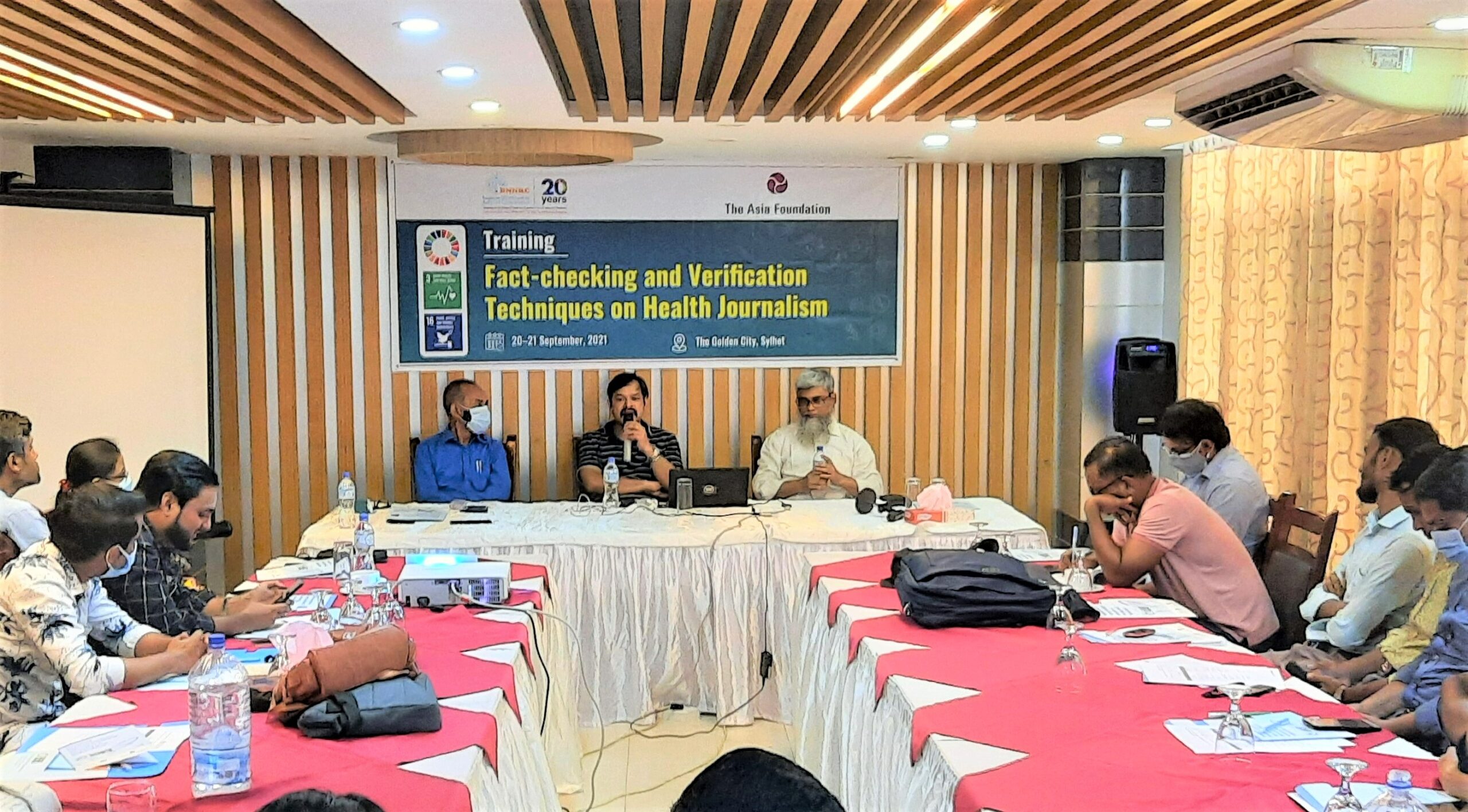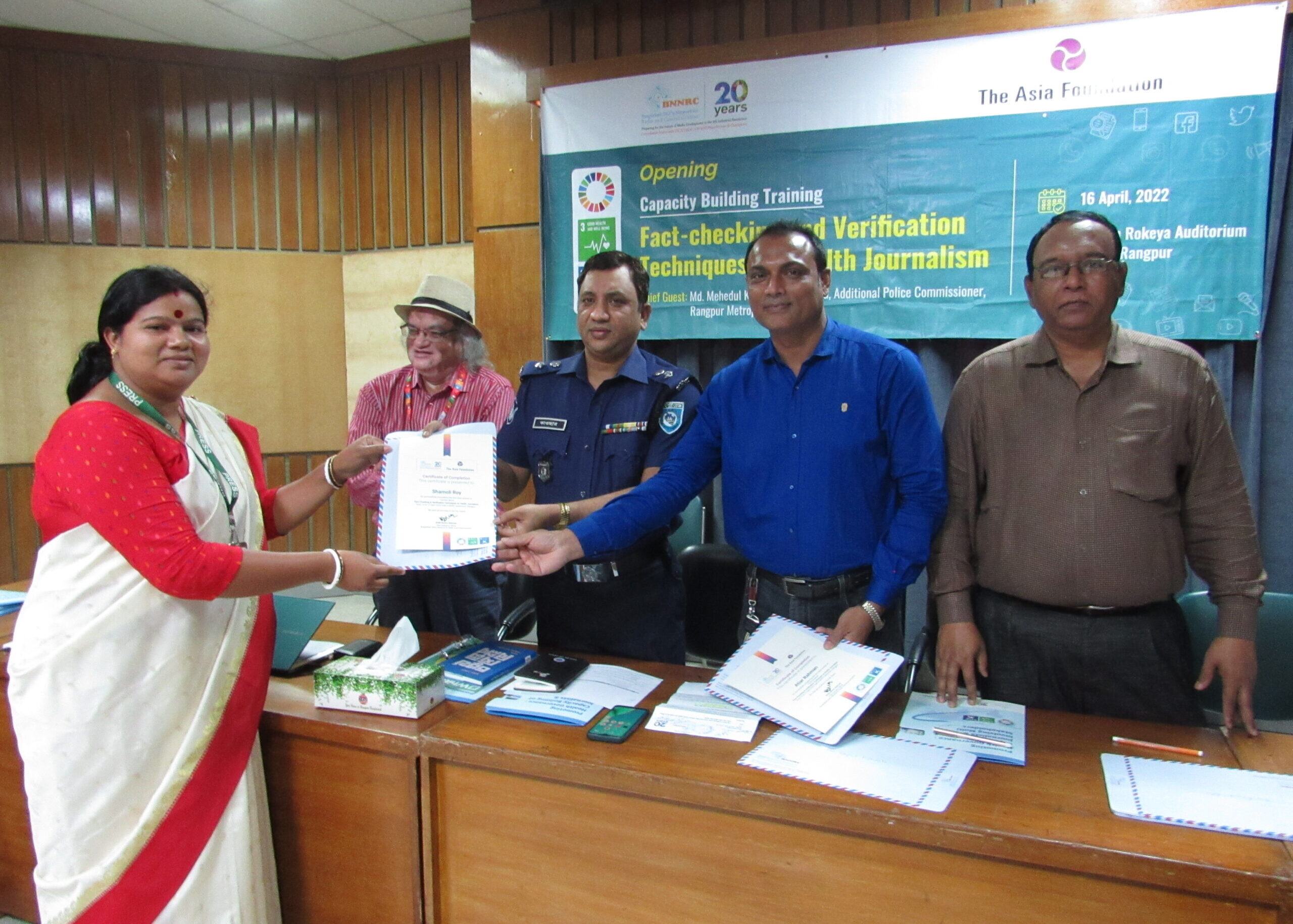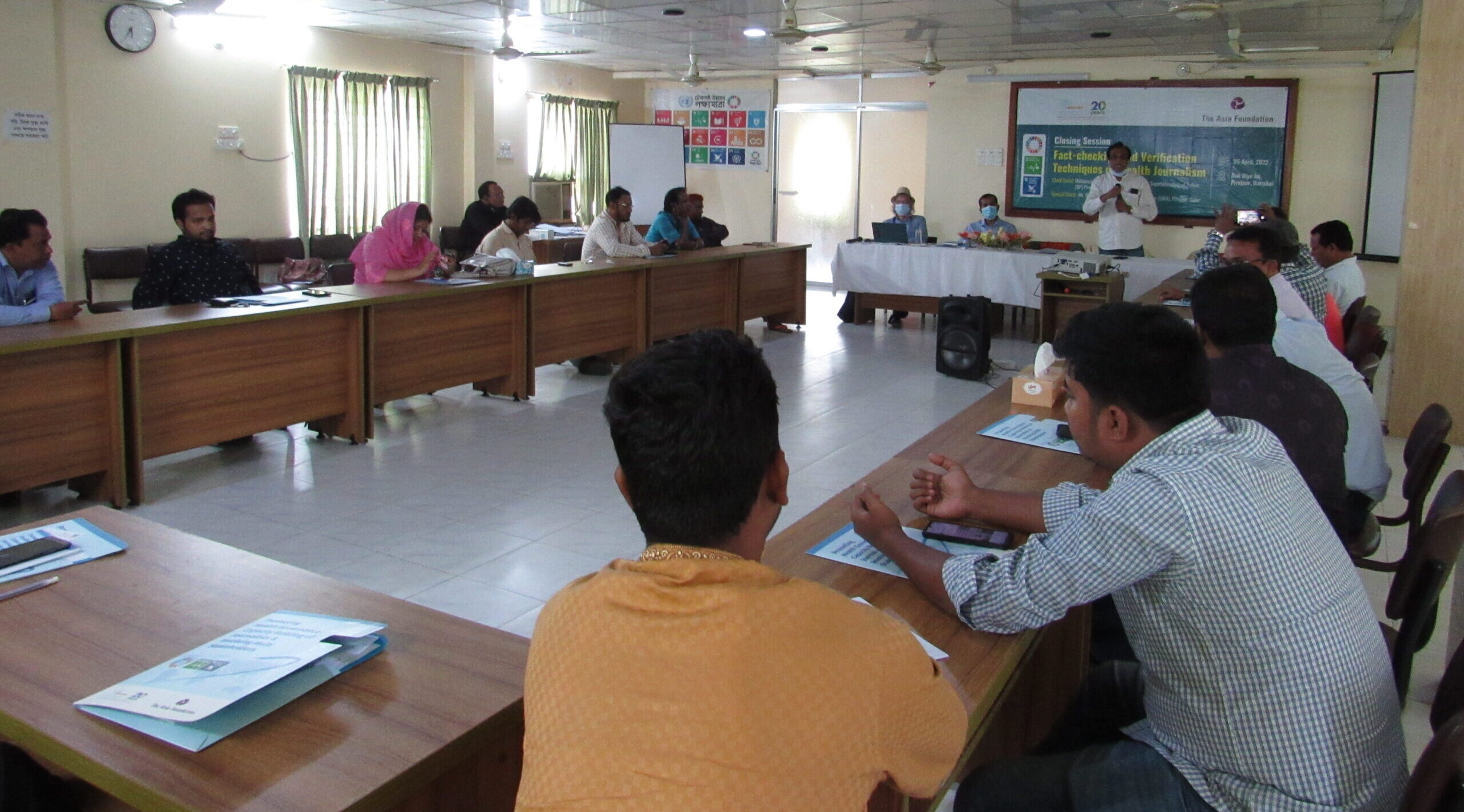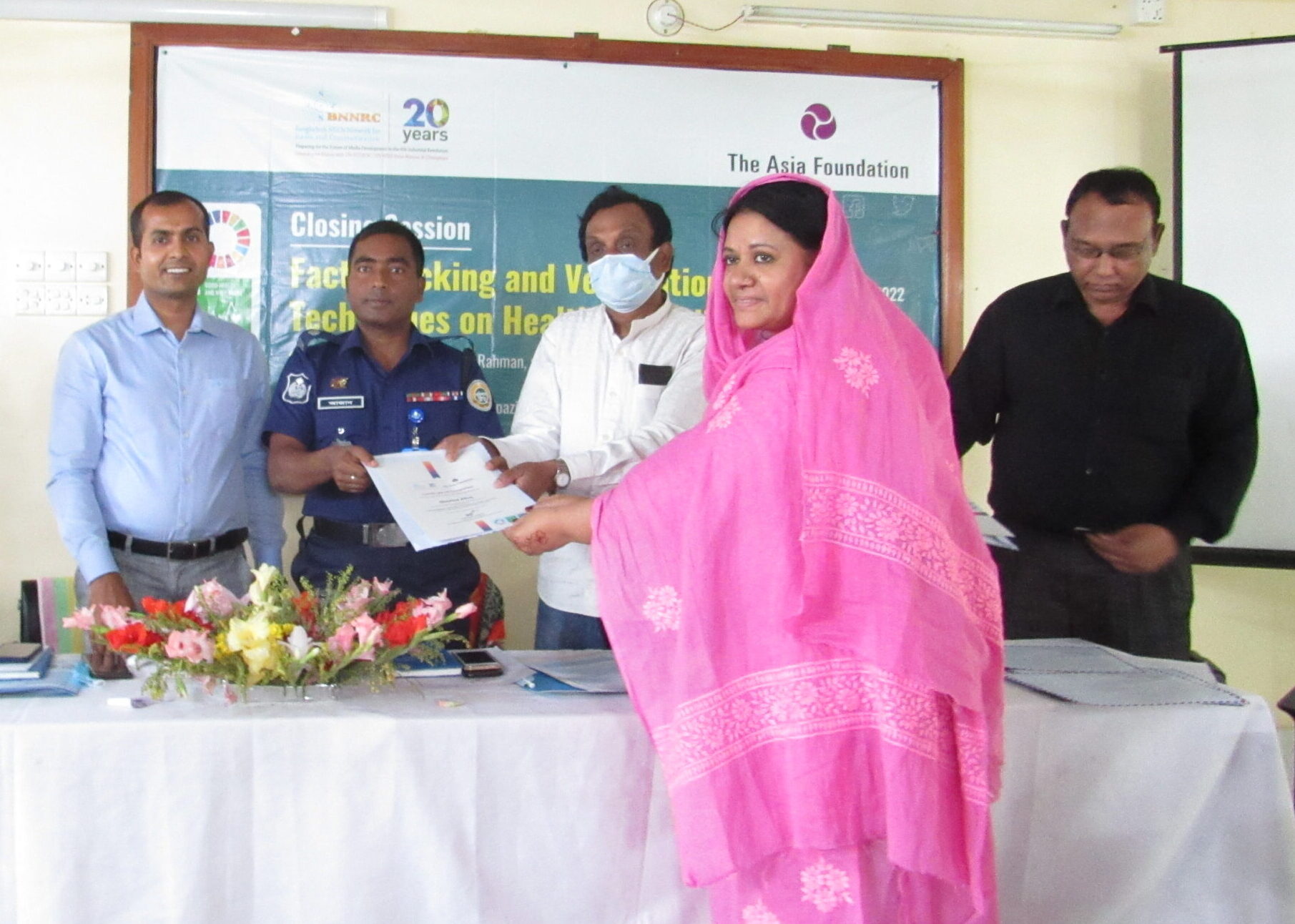Organization: Bangladesh NGOs Network for Radio and Communication (BNNRC)
Country: Bangladesh
The goal of the project
Empowering Community People and Promoting Access to Reliable and Timely Information
Objectives
- To disseminate reliable and timely information to fight against Fake news through Fact Checking and Verification
- To teach the techniques of information verification and evaluation before program and content development and broadcast
- Foster key investigative strategies for techniques specialized for verifying information of the journalists can prepare factual, investigative, and influential reports
- Increased access to critical fact-based journalism on that journalists can produce more responsible, accurate, balanced, and credible news
Description: Please provide a short description of the project in 150 to 200 words describing the project’s objectives, results achieved, and impact generated.
Bangladesh NGOs Network for Radio & Communication (BNNRC), has been implementing initiatives to create enabling environment fighting fake news through fact-checking and verification for the journalists.
Media can contribute strongly to the public interest only when the journalists will be allowed to perform their duties skillfully in the event of a crisis. In the age of fast-growing information technology, journalists must adapt to the techniques of checking genuine facts and learn best practices in ethical news writing. The objective of reporting on issues through fact-checking and verification techniques is to consider the issue with sharp insight and to create a detailed report which will have an important contribution to the development of the health sector as well as quality health services for all.
Journalists are required to have relevant skills and expertise to evaluate the facts behind the fact and unfold the genuine reason for responsible, accurate, balanced, and credible news reporting.
The purpose of the project was to enhance the capacity of journalists working in creating and publishing objective, insightful and influential news, and encourage journalists to acquire knowledge and skills in modern techniques in data verification and presentation in creating neutral and balanced reports. Fact-checking is very important. The project, “Fighting Fake News through Fact Checking and Verification” through journalists in Bangladesh aims to disseminate to fight against fake news through Fact-checking and verification.

Other target beneficiary group(s)
The programs will be benefitted all community people as a whole for identifying the fake news of the reports of the journalists.
Please describe how and where this project is replicable.
The activities are to be implemented to aware the community media and all other media houses of the country particularly broadcasters and journalists involved in working with the identification of fake news through fact-checking in the digital age. Concerned Service Providers who are positive for providing their services, will be carried out through a series of programs, which is replicable in any community.
As community radio has always inspired the marginalized to share opinions to address political and social action. Besides, it would be used as a tool for both active and passive communication and outreach worldwide. Besides, Social Media Campaign through the Facebook page will act as a virtual platform for young people who have ideas to share on how to prevent fake news from the media.

Please describe how this project is sustainable.
The ability of the journalist through fact-checking and verification techniques training is enhanced through the interventions of fact-checking thus they can take the initiative to cope with the practice and respective media houses will adopt the concept through the media. The media houses have incorporated the issues of fact-checking with their regular program and content development and trying to fight against, fake news and avoid them. How this topic has been discussed and shaped by Broadcasters, the news media, and academics. The journalists and broadcasters understand how harm and falsity are ways of thinking about ‘information disorder’.
The journalists and broadcasters learned critically about an example of fake news breaking down who initiated and created it, what the message looked like, and how it might have been interpreted by audiences and readers. Explain to someone else why it is important that we think about this issue carefully. Increased likelihood of fake news going viral with distribution amplified by ‘trust networks and emotional reactions. Critically assess the structural causes and the broad consequences of the news media’s actions in reporting and distributing fake news. Understand and critique the role of technology and the ‘new gatekeepers’ in enabling the viral distribution of fake news presented as news. Identify emerging best practices within the news industry for catching and combatting fake news.

How does this project promote WSIS values in your community?
The project aims to provide capacity-building of journalists for fighting fake through fact-checking and verification to ensure news and credible information to the community people. The project also supports gender equality and provides girls with assistance in development in the field of journalism.
Contribution to the implementations of WSIS Action Lines and the Sustainable Development Goals
Please describe how does the project contribute to the implementation of the selected WSIS Action Lines and Sustainable Development Goals.
Through this intervention, WSIS values (Action line- C4) in Bangladeshi journalist communities are strongly adhered and promoted extensively. This is done through building the capacity of youth and youth women journalists and encouraging up-skilling on technology and digital literacy as well as self-learning for fighting fake news through fact checking.
Sustainable development goals (SDGs)
The capacity-building programs and achieved through this project are linked to the SGDs in the following ways:
SDG-5. Achieve gender equality and empower all women journalists: The program provided support for women journalists on the issue of constructive journalism primarily focused on developing credible news for the community.
SDG-8. Promote sustained, inclusive and sustainable economic growth, full and productive employment and decent work for all: The initiatives developed and certified digital competencies for the journalists in various levels that help to employment and decent work
SDG-9.C- Significantly increase access to information and communications technology and strive to provide universal and affordable access to the Internet in the least developed countries by 2020: The initiatives help to mobilize and aware the media houses for meaningful access to information and communications technology at a different level.
SDG-16. Promote peaceful and inclusive societies for sustainable development, provide access to justice for all and build effective, accountable and inclusive institutions at all levels: The initiative fighting fake news through fact-checking and verification techniques was focused on the topics of peace and inclusion and producing credible news and information contributing SDGS-16.2 in particularly.

Executive Summary
The internet makes it easy for billions of people to access information with a few simple keystrokes. However, it also makes it easy to spread false information, which can have disastrous effects on both individuals and society as a whole. For this reason, it’s important to fact-check sources of information.
Fact-checking is important because misinformation can control your opinion. In turn, our opinion can largely inform all actions. If you base your actions on false information and fake news, you can easily make the wrong decisions. These decisions can lead to unintended consequences. For example, if you share fake news on a social media platform and people find out it’s fake, it could negatively impact their opinion of its credibility. Or the fake news you share could go viral and shape the outcome of an election.
The best way to counter fake news is to conduct your own research. The journalist community can contribute to fighting fake news through fact-checking and verification about misinformation and fake news, how to evaluate sources of information, where to find reputable information, and where to look for fact-checking tools.
Fake news has become an important issue for the media today in the world. It is also a challenge for Bangladesh to information that is false, inaccurate, and fabricated with no verification of facts a statement sent or propaganda without reliability is harmful to the society and country. So, Fact-checking is very important. The project, “Fighting Fake News through Fact Checking and Verification” through journalists in Bangladesh aims to disseminate to fight against fake news through Fact-checking and verification.
161 journalists from different print electronic and online media across the country worked to fight against fake news through fact-checking. The journalists have published and broadcasted different reports on how to fight against fake news through fact-checking and verification. The intervention has accelerated ICT applications for benefitting community people in all aspects of life through effective public access to reliable and timely information through ICT and media for fighting against the infodemic and keeping lives & livelihood easy.
The journalists with their new technologies and ideas are working for fighting against fake news. The claim for evidence concept of fact-checking requires greater analytical depth and skills to broadcast programs to fight against the issues.
The intention of Fact-Checking and Verification program for mainstream media needs more insightful, comprehensive, and thus more influential. In the age of fast-growing information technology, it is necessary to adopt the techniques of checking genuine facts and learn best practices in the ethical program.
During the implementation of the project following issues have been emphasized. The media cannot always guarantee ‘truth’ but being accurate and getting the facts right remains a cardinal principle of media. This means not acting, formally or informally, on behalf of special interests and declaring anything that might constitute a conflict of interest, in the interests of transparency. Transparency in practice supports accountability and assists in the development and maintenance of trust in journalism. Fair reporting of information, events, sources, and their stories involves sifting, weighing, and evaluating information open-mindedly and perspicaciously. Providing context and presenting a range of competing perspectives builds trust and confidence in reporting.
People’s perception is very important regarding fake news, how it is being combated, and what else can be done to fight against the issue. In the context of Bangladesh, the spread of issues is very high. Bangladesh has experienced several incidents of mob lynching and hates attacks caused by the spread of inaccurate and misleading information on digital media. A series of mob attacks killed people after misinformation about child abduction spread online. Fake news led to violence when a Facebook post of a local Buddhist youth included a photo of a burned copy of the Quran. It was later found that the image was photoshopped and someone else posted the image on the youth’s Facebook page. Fake news has also been a growing concern in Bangladesh where duplicate websites copying some legacy news organizations were created to spread misleading political news at different times.
During the beginning COVID-19 crisis there are myths and misconceptions are prevailing in the Community such as COVID-19 Virus can be killed from the body through spraying alcohol or chlorine on the body, protect COVID-19 virus using hot water during a shower, eating garlic can protect from COVID-19, only old age people and children will be infected by COVID-19.
There has been a growing interest within the community in understanding the characteristics of fake propagated through digital media and the devising techniques to address the associated challenges.
Considering this situation in Bangladesh, BNNRC has been implementing a project titled ‘Fighting Fake News through Fact Checking and Verification’ in Bangladesh’ to address the challenges of promoting a peaceful society. BNNRC has been working to fight fake news through 161 journalists from print, electronic and online media. BNNRC organized Fact Checking and Verification Techniques training for the journalists. The journalists learned about Google Fact Check Explorer, Accessing the Fact Check Markup tool, Adding Claim Reviews to your fact checks, and Google Fact Check Markup API and other sources. Fact-checking and verification are confirming the validity or expose the falseness and fake issues.
The journalists with their new technologies and ideas are working for Fighting Fake News through Fact Checking and Verification. The claim for evidence concept of fact-checking requires greater analytical depth knowledge and skills to publish and broadcast programs to fight against fake news.
The intention of Fact-Checking for program Broadcasting needs more insightful, comprehensive, and thus more influential. In the age of fast-growing information technology, it is necessary to adopt the techniques of checking genuine facts and learn best practices in ethical programs. The ability of the journalists is enhanced through the interventions of fact-checking thus they can take the initiative to cope with the practice and respective media houses will adopt the concept through the media.
The journalists deepened their critical understanding of how the media can better serve in fighting against fake news and open societies in a vastly expanded media environment, and the risks of ‘information disorder’ to the country. Understood the factors that drive trust in media and how much trust can be sustained or rebuilt. Being able to explain to someone else why the media are working matters.
Journalists to check and examine fake news and rumors carefully and steps to be taken to the prevention of their spreading. Check the date of information or news, the screenshot is not reliable because it may be created by photoshop check the link of information

Implementing partners
BNNRC has implemented the project directly but the following media houses are involved with the initiative: Bhorer Kagoj, Bonik Barta, The Business Standard, Daily Jaijaidin, Daily Jugantor, Daily Ittefaq, Daily Samakal, Bangladesh Protidin, The Daily Star, Daily Gramer Kagoj, Jashore, Daily Samajer Katha, Jashore, Daily Spandan, Jashore, The Daily Jessore, Daily Protidiner Katha, Jashore, Protidiner Sangbad, Shyamal Sylhet, Daily Sylheter Zamin, Daily Sabuj Sylhet, Daily Vorer Pata, Daily Uttorpurbo, The Peoples Time, Sangbad, Daily Sylhet Mirror, Daily Jugabhery
Daily ekattorerkotha, NTV, Bangla Vision, Bangladesh Television (BTV), Jamuna Television, Mohona TV, Somoy TV, Boishakhi TV, Independent TV, 71 TV, Channel 24, News 24, syltv.com, Deepto TV, Bangla TV, Ekushey TV, DBC News, Banglanews 24.com, Bangla Tribune, Sarabangla.net, News Bangla24.com, Bdnews24.com, www.dhakapost.com, www.khulnagazette.com, sylhetview24.com, dailybdnews.net, sylhetexpress.com, khoborsobor.com, www.bdnews24.com, Bangladesh Betar, Bangladesh Sangbad Sangstha, The weekly Pirojpur Bani.
Impact
The journalists with their new technologies and ideas are working for combating fake news, rumors, and false information. The claim for evidence concept of fact-checking requires greater analytical depth and skills to broadcast programs to fight against fake news. The intention of Fact-Checking for program media houses needs more insightful, comprehensive, and thus more influential. In the age of fast-growing information technology, it is necessary to adopt the techniques of checking genuine facts and learn best practices in the ethical program.
Deepened their critical understanding of how media can better serve for fighting against fake news and open societies in a vastly expanded media environment, and the risks of ‘information disorder’ to the country. Understood the factors that drive trust in media and how much trust can be sustained or rebuilt. Being able to explain to someone else why media are working matters.
Challenges and future perspectives for the project
The theme of fighting fake news fact-checking and verification through journalists is comparatively new in Bangladeshi media and it would be more or less challenging to introduce the issue to all media.
Mobilizing media on the theme would be a huge task with limited data and information from the ground. The media outlets need to understand more about what causes of fake news. The media need to know where to look for these causes and solutions. The lack of experienced resource persons to train the media is another challenge faced by the media.
The interventions have certainly generated tremendous enthusiasm among the participating journalists which encourages the media outlets to further plan and design how best to extend and expand the ideas among all print and electronic media.
About: BNNRC
Bangladesh NGOs Network for Radio and Communication represents the community media sector to Government, Industry, Regulatory Bodies, Media, and Development Partners.
BNNRC has been struggling for the last 20 years to open up the community media (including Community Radio, Community Television) and giving focus on its vital role as voices of the voiceless rural people. The reality of today is that the bondage between the community people and local-level community radio stations is getting strengthened day-by-day. Community Radio has now become their part of life and livelihood.


